Wawasan Open University: BBM 102/05 Microeconomics Assignment Solution
VerifiedAdded on 2023/06/07
|10
|1299
|403
Homework Assignment
AI Summary
This microeconomics assignment solution delves into fundamental economic concepts such as scarcity, choice, and opportunity cost, differentiating between microeconomics and macroeconomics. It analyzes market equilibrium, the impact of changing demand on revenue, and the effects of price control schemes in Malaysia, including their consequences and potential improvements. Furthermore, it calculates and interprets price elasticity of demand and cross-price elasticity, assessing the nature of demand for Indocafe and its relationship with Nescafe. The solution provides a comprehensive understanding of these core microeconomic principles and their practical applications.

Running Head: MICROECONOMICS
Microeconomics
Name of the Student
Name of the University
Course ID
Microeconomics
Name of the Student
Name of the University
Course ID
Paraphrase This Document
Need a fresh take? Get an instant paraphrase of this document with our AI Paraphraser
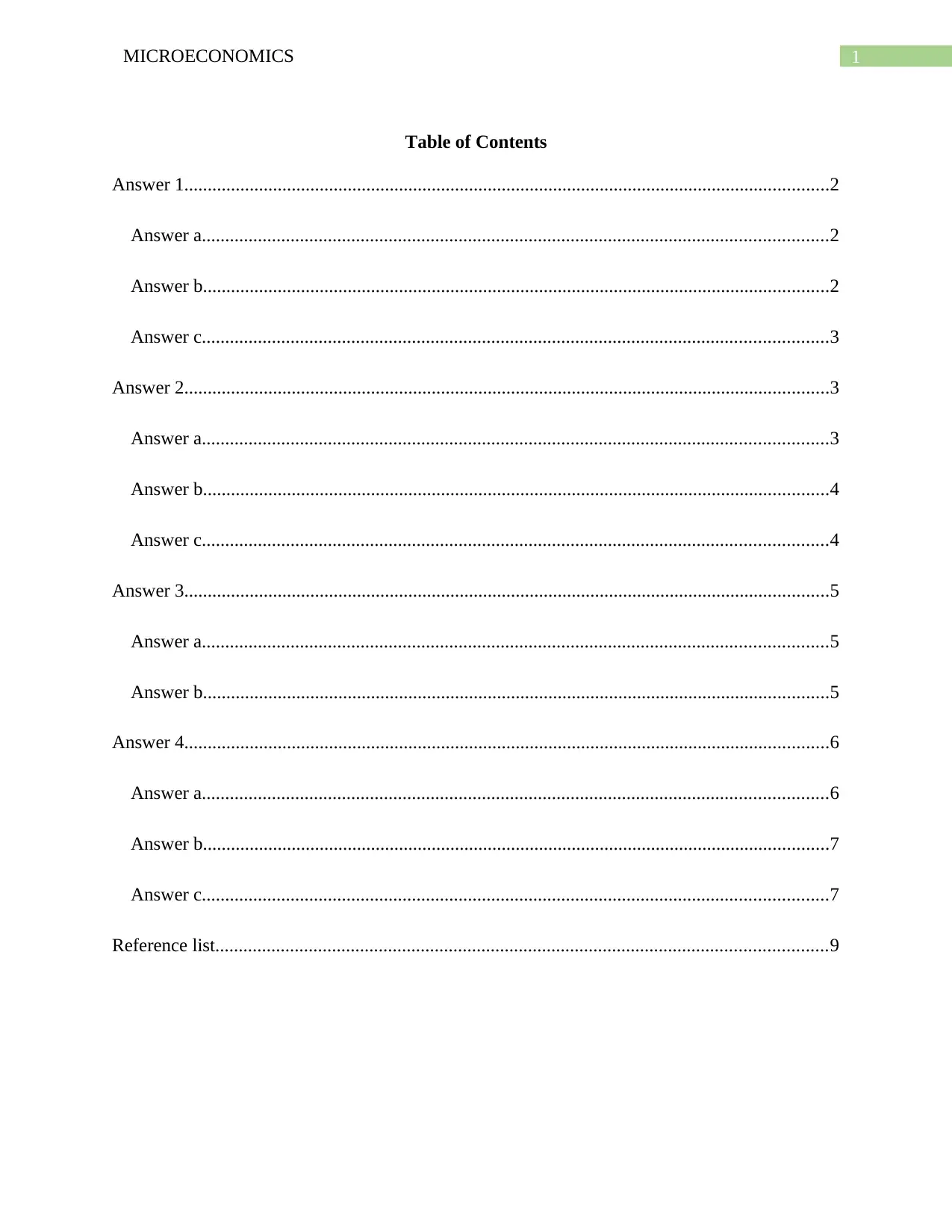
1MICROECONOMICS
Table of Contents
Answer 1..........................................................................................................................................2
Answer a......................................................................................................................................2
Answer b......................................................................................................................................2
Answer c......................................................................................................................................3
Answer 2..........................................................................................................................................3
Answer a......................................................................................................................................3
Answer b......................................................................................................................................4
Answer c......................................................................................................................................4
Answer 3..........................................................................................................................................5
Answer a......................................................................................................................................5
Answer b......................................................................................................................................5
Answer 4..........................................................................................................................................6
Answer a......................................................................................................................................6
Answer b......................................................................................................................................7
Answer c......................................................................................................................................7
Reference list...................................................................................................................................9
Table of Contents
Answer 1..........................................................................................................................................2
Answer a......................................................................................................................................2
Answer b......................................................................................................................................2
Answer c......................................................................................................................................3
Answer 2..........................................................................................................................................3
Answer a......................................................................................................................................3
Answer b......................................................................................................................................4
Answer c......................................................................................................................................4
Answer 3..........................................................................................................................................5
Answer a......................................................................................................................................5
Answer b......................................................................................................................................5
Answer 4..........................................................................................................................................6
Answer a......................................................................................................................................6
Answer b......................................................................................................................................7
Answer c......................................................................................................................................7
Reference list...................................................................................................................................9

2MICROECONOMICS
Answer 1
Answer a
Scarcity
Scarcity indicate the basic problem in economics representing the gap between limitless
wants of people and limited resources. The presence of scarcity induces people to utilize
resources efficiently so that it can fulfill maximum possible wants.
Choices
The economic problem of scarcity leads to the problem of choices. Because of scarcity
people have to make choice among available alternatives. Choice refers to the decision that
people need to make regarding the use of limited resources.
Opportunity cost
Opportunity cost is regarded as one of the most important concept in economics.
Following scarcity and choice people have to sacrifice something to get another (Baumol and
Blinder 2015). Opportunity cost is the cost associated for sacrificing the next best alternative
while taking decision.
Answer b
Microeconomics and Macroeconomics
The branch of economics called Microeconomics deals with decision making and choice
of individual economic agents. More specifically, it considers decision making of a single firm or
consumer and its consequence on single market. Macroeconomics on the other hand deals with
aggregate or total choice related to economic activity.
Answer 1
Answer a
Scarcity
Scarcity indicate the basic problem in economics representing the gap between limitless
wants of people and limited resources. The presence of scarcity induces people to utilize
resources efficiently so that it can fulfill maximum possible wants.
Choices
The economic problem of scarcity leads to the problem of choices. Because of scarcity
people have to make choice among available alternatives. Choice refers to the decision that
people need to make regarding the use of limited resources.
Opportunity cost
Opportunity cost is regarded as one of the most important concept in economics.
Following scarcity and choice people have to sacrifice something to get another (Baumol and
Blinder 2015). Opportunity cost is the cost associated for sacrificing the next best alternative
while taking decision.
Answer b
Microeconomics and Macroeconomics
The branch of economics called Microeconomics deals with decision making and choice
of individual economic agents. More specifically, it considers decision making of a single firm or
consumer and its consequence on single market. Macroeconomics on the other hand deals with
aggregate or total choice related to economic activity.
⊘ This is a preview!⊘
Do you want full access?
Subscribe today to unlock all pages.

Trusted by 1+ million students worldwide
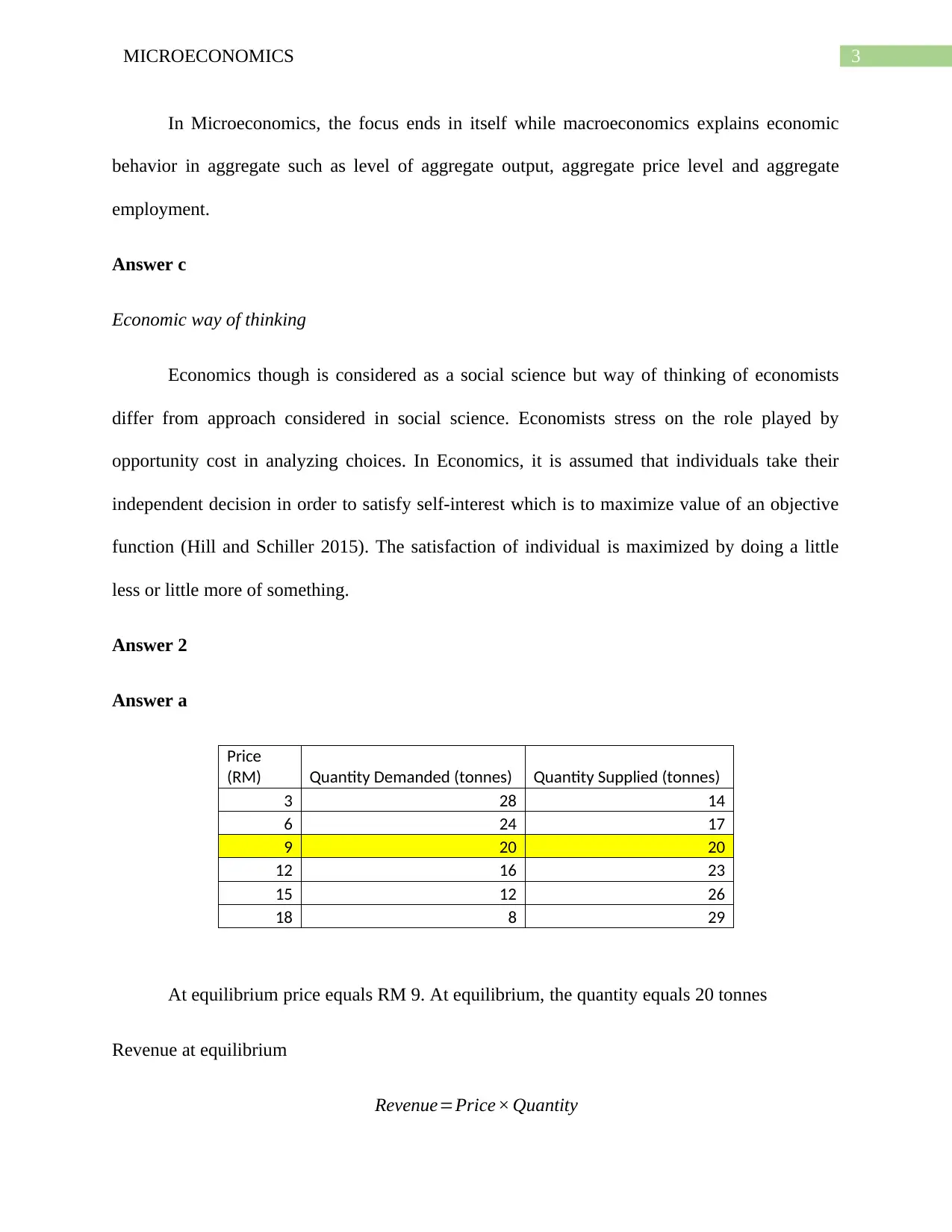
3MICROECONOMICS
In Microeconomics, the focus ends in itself while macroeconomics explains economic
behavior in aggregate such as level of aggregate output, aggregate price level and aggregate
employment.
Answer c
Economic way of thinking
Economics though is considered as a social science but way of thinking of economists
differ from approach considered in social science. Economists stress on the role played by
opportunity cost in analyzing choices. In Economics, it is assumed that individuals take their
independent decision in order to satisfy self-interest which is to maximize value of an objective
function (Hill and Schiller 2015). The satisfaction of individual is maximized by doing a little
less or little more of something.
Answer 2
Answer a
Price
(RM) Quantity Demanded (tonnes) Quantity Supplied (tonnes)
3 28 14
6 24 17
9 20 20
12 16 23
15 12 26
18 8 29
At equilibrium price equals RM 9. At equilibrium, the quantity equals 20 tonnes
Revenue at equilibrium
Revenue=Price× Quantity
In Microeconomics, the focus ends in itself while macroeconomics explains economic
behavior in aggregate such as level of aggregate output, aggregate price level and aggregate
employment.
Answer c
Economic way of thinking
Economics though is considered as a social science but way of thinking of economists
differ from approach considered in social science. Economists stress on the role played by
opportunity cost in analyzing choices. In Economics, it is assumed that individuals take their
independent decision in order to satisfy self-interest which is to maximize value of an objective
function (Hill and Schiller 2015). The satisfaction of individual is maximized by doing a little
less or little more of something.
Answer 2
Answer a
Price
(RM) Quantity Demanded (tonnes) Quantity Supplied (tonnes)
3 28 14
6 24 17
9 20 20
12 16 23
15 12 26
18 8 29
At equilibrium price equals RM 9. At equilibrium, the quantity equals 20 tonnes
Revenue at equilibrium
Revenue=Price× Quantity
Paraphrase This Document
Need a fresh take? Get an instant paraphrase of this document with our AI Paraphraser

4MICROECONOMICS
¿ 9 ×20
¿ RM 180
Answer b
As the study reveals rice is bad for health. Demand for rice at ever prices reduces by 7
tonnes.
Price
(RM) Quantity Demanded (tonnes) Quantity Supplied (tonnes)
3 21 14
6 17 17
9 13 20
12 9 23
15 5 26
18 1 29
The new equilibrium occurs at price and quantity equals RM 6 and 17 tonnes respectively.
Answer c
New revenue is obtained as
Revenue=Price× Quantity
¿ 6 ×17
¿ RM 102
Earlier the revenue was RM 180. After a decline in demand, equilibrium occurs at a lower price
and lower quantity demanded. As a result, under new equilibrium revenue decrease to RM 102.
Answer 3
¿ 9 ×20
¿ RM 180
Answer b
As the study reveals rice is bad for health. Demand for rice at ever prices reduces by 7
tonnes.
Price
(RM) Quantity Demanded (tonnes) Quantity Supplied (tonnes)
3 21 14
6 17 17
9 13 20
12 9 23
15 5 26
18 1 29
The new equilibrium occurs at price and quantity equals RM 6 and 17 tonnes respectively.
Answer c
New revenue is obtained as
Revenue=Price× Quantity
¿ 6 ×17
¿ RM 102
Earlier the revenue was RM 180. After a decline in demand, equilibrium occurs at a lower price
and lower quantity demanded. As a result, under new equilibrium revenue decrease to RM 102.
Answer 3
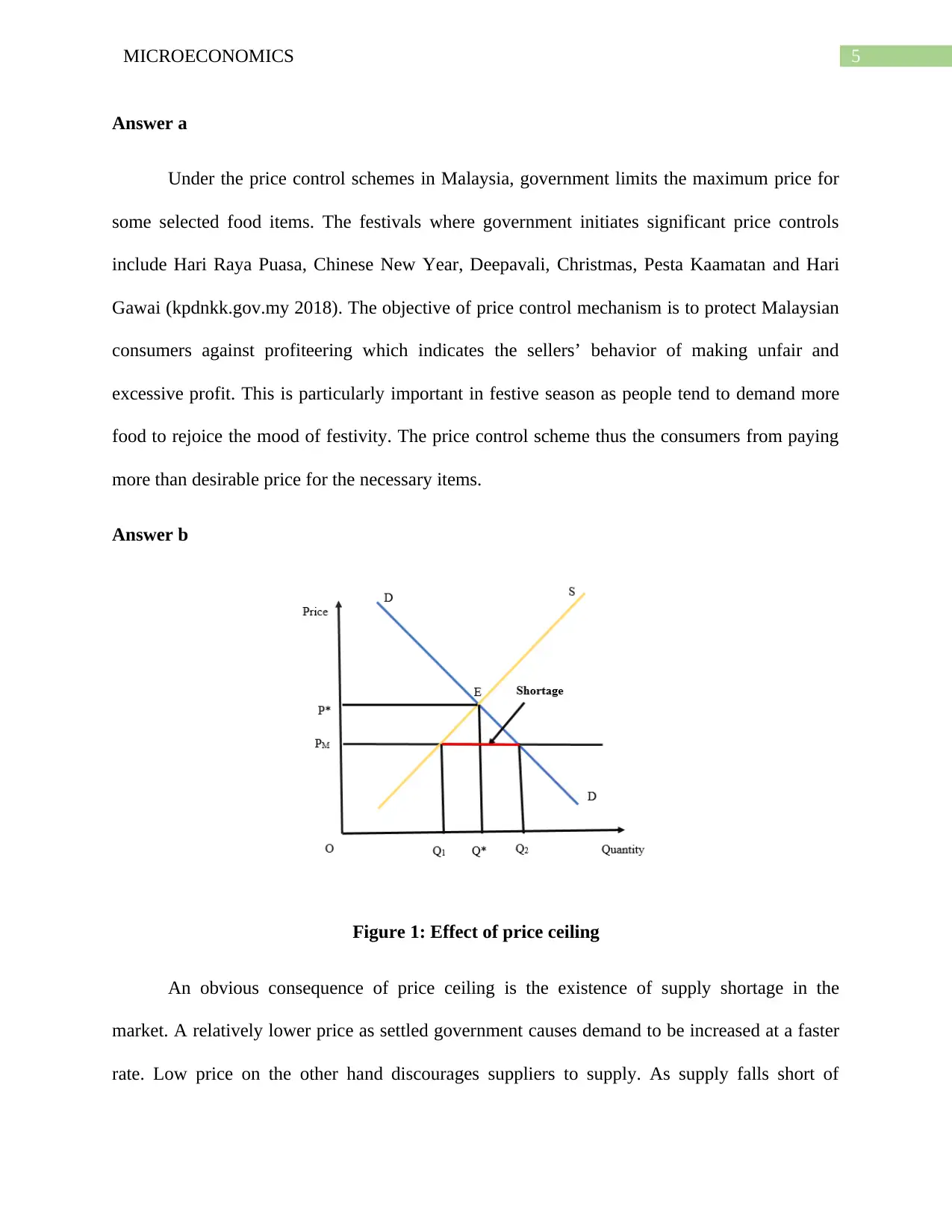
5MICROECONOMICS
Answer a
Under the price control schemes in Malaysia, government limits the maximum price for
some selected food items. The festivals where government initiates significant price controls
include Hari Raya Puasa, Chinese New Year, Deepavali, Christmas, Pesta Kaamatan and Hari
Gawai (kpdnkk.gov.my 2018). The objective of price control mechanism is to protect Malaysian
consumers against profiteering which indicates the sellers’ behavior of making unfair and
excessive profit. This is particularly important in festive season as people tend to demand more
food to rejoice the mood of festivity. The price control scheme thus the consumers from paying
more than desirable price for the necessary items.
Answer b
Figure 1: Effect of price ceiling
An obvious consequence of price ceiling is the existence of supply shortage in the
market. A relatively lower price as settled government causes demand to be increased at a faster
rate. Low price on the other hand discourages suppliers to supply. As supply falls short of
Answer a
Under the price control schemes in Malaysia, government limits the maximum price for
some selected food items. The festivals where government initiates significant price controls
include Hari Raya Puasa, Chinese New Year, Deepavali, Christmas, Pesta Kaamatan and Hari
Gawai (kpdnkk.gov.my 2018). The objective of price control mechanism is to protect Malaysian
consumers against profiteering which indicates the sellers’ behavior of making unfair and
excessive profit. This is particularly important in festive season as people tend to demand more
food to rejoice the mood of festivity. The price control scheme thus the consumers from paying
more than desirable price for the necessary items.
Answer b
Figure 1: Effect of price ceiling
An obvious consequence of price ceiling is the existence of supply shortage in the
market. A relatively lower price as settled government causes demand to be increased at a faster
rate. Low price on the other hand discourages suppliers to supply. As supply falls short of
⊘ This is a preview!⊘
Do you want full access?
Subscribe today to unlock all pages.

Trusted by 1+ million students worldwide

6MICROECONOMICS
demand, the market suffers with a supply shortage. Malaysian government though adapts the
policy of controlling rice by setting a limit on it but fails to ensure sufficient supply. People in
Malaysia in different festival such as Hari Raya, Chinese New Year or Deepavali suffer with
supply side shortage of food in the market (nst.com.my 2018).
Setting the upper limit is not sufficient to control price. Measures should be taken to
prevent unwanted consequence of such policy. To efficiently control price, government should
provide some subsidy to seller so that they can able to supply sufficient quantity at the lower
price. Besides, restriction should also be placed on quantity demanded that is lower price should
be available up to a certain limit. This can help to control excess demand and makes price control
more effective.
Answer 4
Answer a
Price elasticicity of demand= Percentage change ∈quantity demanded
Percentage change∈price
¿
Q2−Q1
Q2+ Q1
2
× 100
P2−P1
P2+ P1
2
× 100
¿
150−200
150+200
2
×100
3−2
3+2
2
×100
demand, the market suffers with a supply shortage. Malaysian government though adapts the
policy of controlling rice by setting a limit on it but fails to ensure sufficient supply. People in
Malaysia in different festival such as Hari Raya, Chinese New Year or Deepavali suffer with
supply side shortage of food in the market (nst.com.my 2018).
Setting the upper limit is not sufficient to control price. Measures should be taken to
prevent unwanted consequence of such policy. To efficiently control price, government should
provide some subsidy to seller so that they can able to supply sufficient quantity at the lower
price. Besides, restriction should also be placed on quantity demanded that is lower price should
be available up to a certain limit. This can help to control excess demand and makes price control
more effective.
Answer 4
Answer a
Price elasticicity of demand= Percentage change ∈quantity demanded
Percentage change∈price
¿
Q2−Q1
Q2+ Q1
2
× 100
P2−P1
P2+ P1
2
× 100
¿
150−200
150+200
2
×100
3−2
3+2
2
×100
Paraphrase This Document
Need a fresh take? Get an instant paraphrase of this document with our AI Paraphraser
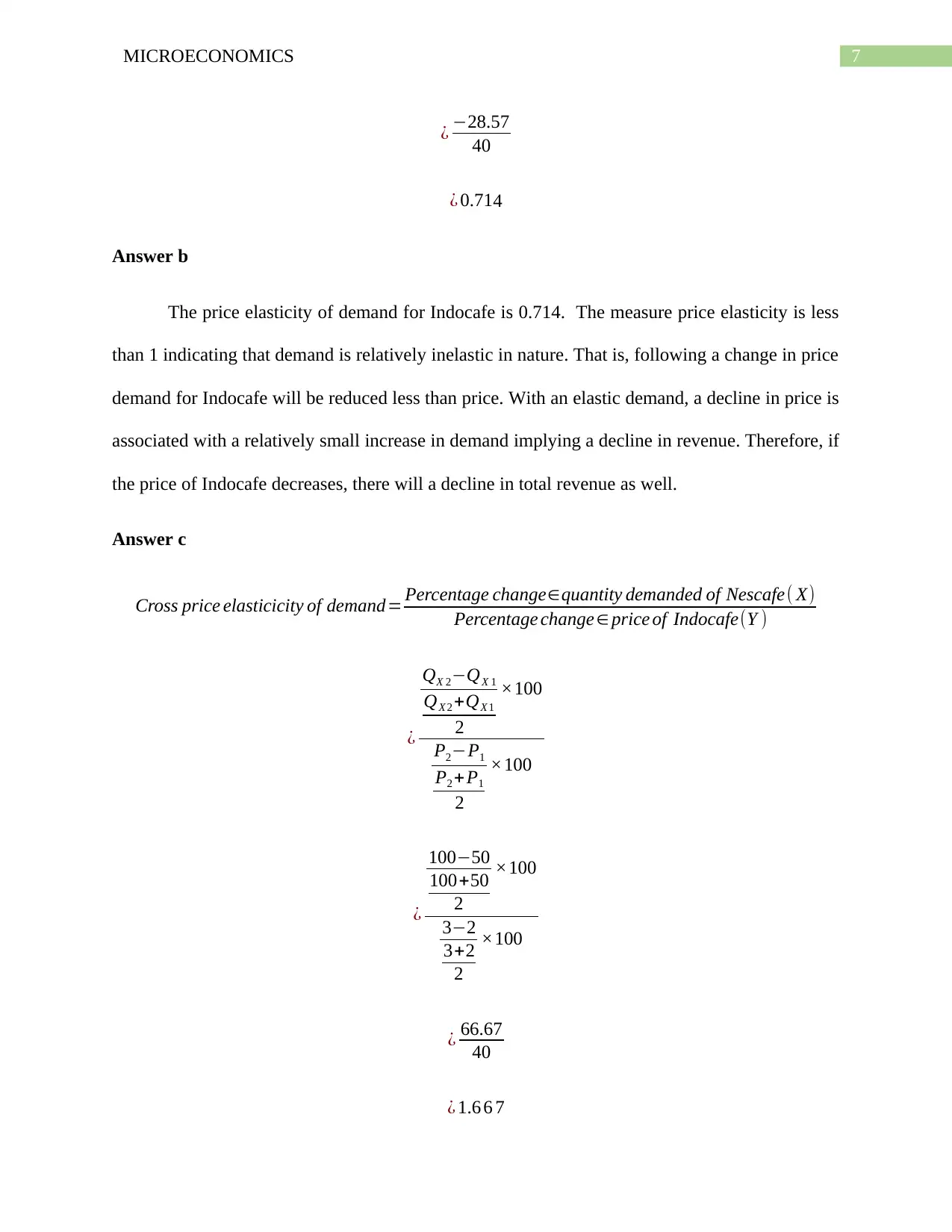
7MICROECONOMICS
¿ −28.57
40
¿ 0.714
Answer b
The price elasticity of demand for Indocafe is 0.714. The measure price elasticity is less
than 1 indicating that demand is relatively inelastic in nature. That is, following a change in price
demand for Indocafe will be reduced less than price. With an elastic demand, a decline in price is
associated with a relatively small increase in demand implying a decline in revenue. Therefore, if
the price of Indocafe decreases, there will a decline in total revenue as well.
Answer c
Cross price elasticicity of demand= Percentage change∈quantity demanded of Nescafe( X)
Percentage change ∈ price of Indocafe(Y )
¿
QX 2−QX 1
QX 2 +QX 1
2
×100
P2−P1
P2 +P1
2
×100
¿
100−50
100+50
2
×100
3−2
3+2
2
×100
¿ 66.67
40
¿ 1.6 6 7
¿ −28.57
40
¿ 0.714
Answer b
The price elasticity of demand for Indocafe is 0.714. The measure price elasticity is less
than 1 indicating that demand is relatively inelastic in nature. That is, following a change in price
demand for Indocafe will be reduced less than price. With an elastic demand, a decline in price is
associated with a relatively small increase in demand implying a decline in revenue. Therefore, if
the price of Indocafe decreases, there will a decline in total revenue as well.
Answer c
Cross price elasticicity of demand= Percentage change∈quantity demanded of Nescafe( X)
Percentage change ∈ price of Indocafe(Y )
¿
QX 2−QX 1
QX 2 +QX 1
2
×100
P2−P1
P2 +P1
2
×100
¿
100−50
100+50
2
×100
3−2
3+2
2
×100
¿ 66.67
40
¿ 1.6 6 7
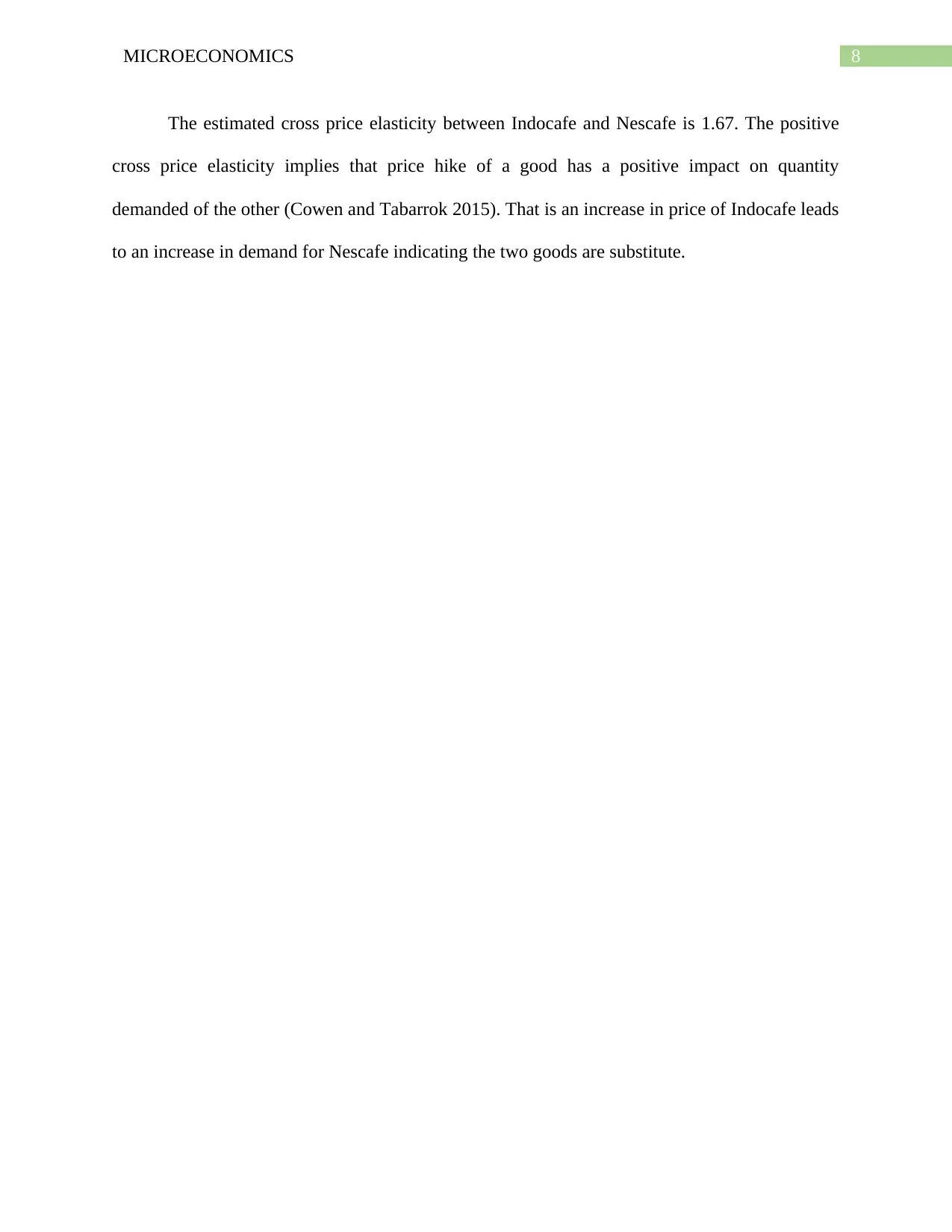
8MICROECONOMICS
The estimated cross price elasticity between Indocafe and Nescafe is 1.67. The positive
cross price elasticity implies that price hike of a good has a positive impact on quantity
demanded of the other (Cowen and Tabarrok 2015). That is an increase in price of Indocafe leads
to an increase in demand for Nescafe indicating the two goods are substitute.
The estimated cross price elasticity between Indocafe and Nescafe is 1.67. The positive
cross price elasticity implies that price hike of a good has a positive impact on quantity
demanded of the other (Cowen and Tabarrok 2015). That is an increase in price of Indocafe leads
to an increase in demand for Nescafe indicating the two goods are substitute.
⊘ This is a preview!⊘
Do you want full access?
Subscribe today to unlock all pages.

Trusted by 1+ million students worldwide
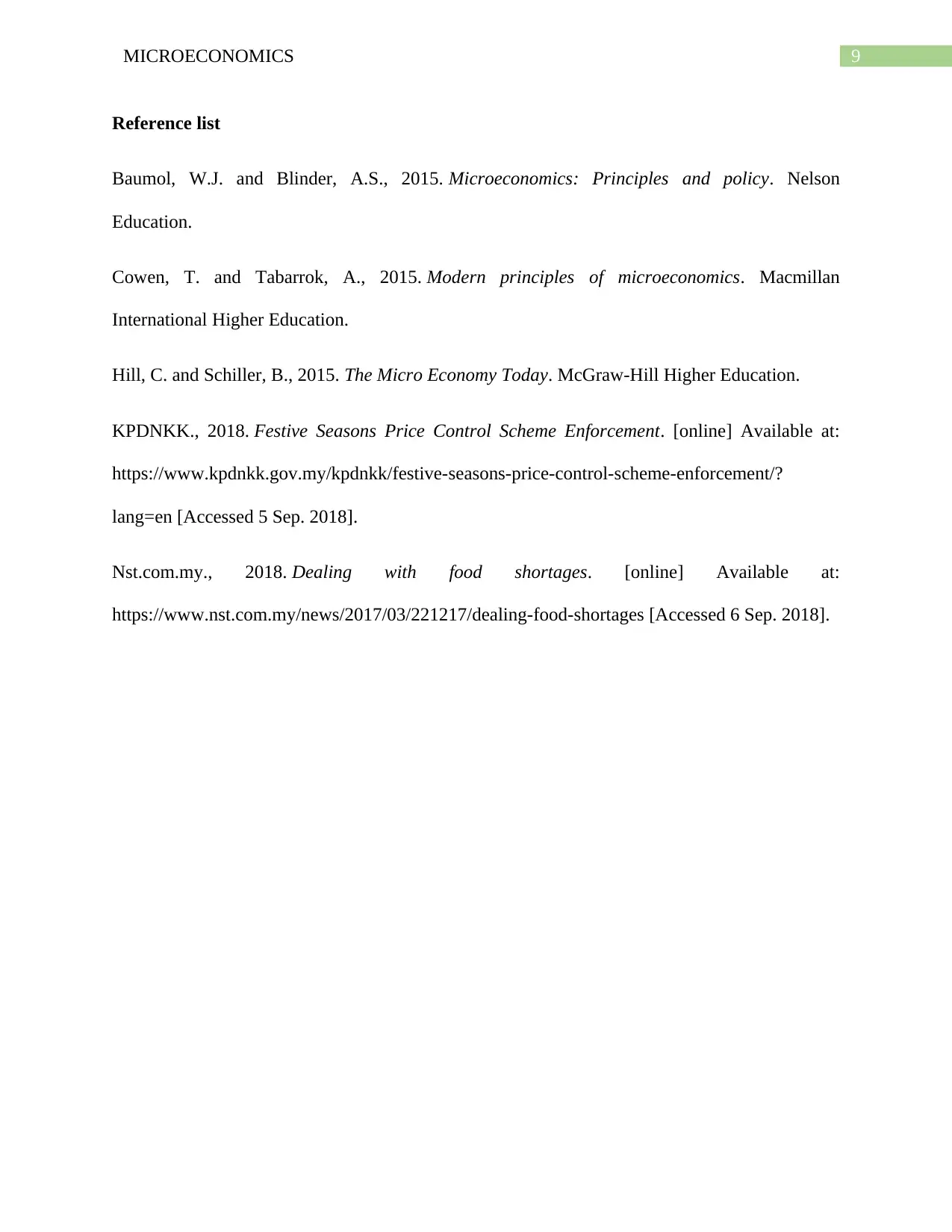
9MICROECONOMICS
Reference list
Baumol, W.J. and Blinder, A.S., 2015. Microeconomics: Principles and policy. Nelson
Education.
Cowen, T. and Tabarrok, A., 2015. Modern principles of microeconomics. Macmillan
International Higher Education.
Hill, C. and Schiller, B., 2015. The Micro Economy Today. McGraw-Hill Higher Education.
KPDNKK., 2018. Festive Seasons Price Control Scheme Enforcement. [online] Available at:
https://www.kpdnkk.gov.my/kpdnkk/festive-seasons-price-control-scheme-enforcement/?
lang=en [Accessed 5 Sep. 2018].
Nst.com.my., 2018. Dealing with food shortages. [online] Available at:
https://www.nst.com.my/news/2017/03/221217/dealing-food-shortages [Accessed 6 Sep. 2018].
Reference list
Baumol, W.J. and Blinder, A.S., 2015. Microeconomics: Principles and policy. Nelson
Education.
Cowen, T. and Tabarrok, A., 2015. Modern principles of microeconomics. Macmillan
International Higher Education.
Hill, C. and Schiller, B., 2015. The Micro Economy Today. McGraw-Hill Higher Education.
KPDNKK., 2018. Festive Seasons Price Control Scheme Enforcement. [online] Available at:
https://www.kpdnkk.gov.my/kpdnkk/festive-seasons-price-control-scheme-enforcement/?
lang=en [Accessed 5 Sep. 2018].
Nst.com.my., 2018. Dealing with food shortages. [online] Available at:
https://www.nst.com.my/news/2017/03/221217/dealing-food-shortages [Accessed 6 Sep. 2018].
1 out of 10
Related Documents
Your All-in-One AI-Powered Toolkit for Academic Success.
+13062052269
info@desklib.com
Available 24*7 on WhatsApp / Email
![[object Object]](/_next/static/media/star-bottom.7253800d.svg)
Unlock your academic potential
Copyright © 2020–2025 A2Z Services. All Rights Reserved. Developed and managed by ZUCOL.




